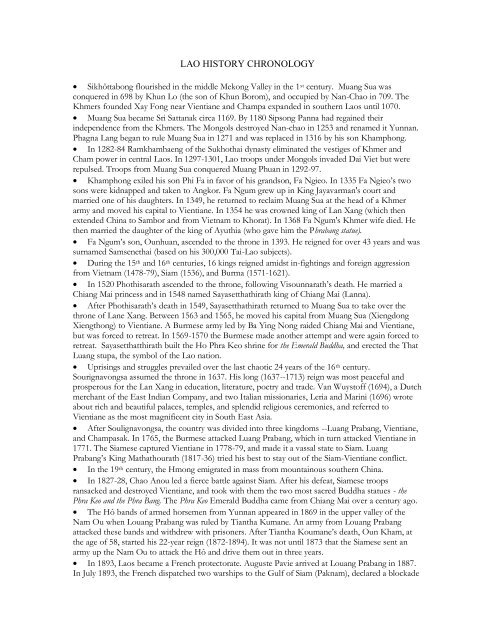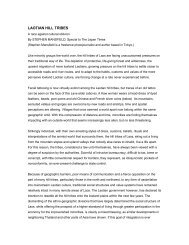Chronology of Lao History - Welcome to Muang Lao new website
Chronology of Lao History - Welcome to Muang Lao new website
Chronology of Lao History - Welcome to Muang Lao new website
You also want an ePaper? Increase the reach of your titles
YUMPU automatically turns print PDFs into web optimized ePapers that Google loves.
LAO HISTORY CHRONOLOGY<br />
Sikhôttabong flourished in the middle Mekong Valley in the 1 st century. <strong>Muang</strong> Sua was<br />
conquered in 698 by Khun Lo (the son <strong>of</strong> Khun Borom), and occupied by Nan-Chao in 709. The<br />
Khmers founded Xay Fong near Vientiane and Champa expanded in southern <strong>Lao</strong>s until 1070.<br />
<strong>Muang</strong> Sua became Sri Sattanak circa 1169. By 1180 Sipsong Panna had regained their<br />
independence from the Khmers. The Mongols destroyed Nan-chao in 1253 and renamed it Yunnan.<br />
Phagna Lang began <strong>to</strong> rule <strong>Muang</strong> Sua in 1271 and was replaced in 1316 by his son Khamphong.<br />
In 1282-84 Ramkhamhaeng <strong>of</strong> the Sukhothai dynasty eliminated the vestiges <strong>of</strong> Khmer and<br />
Cham power in central <strong>Lao</strong>s. In 1297-1301, <strong>Lao</strong> troops under Mongols invaded Dai Viet but were<br />
repulsed. Troops from <strong>Muang</strong> Sua conquered <strong>Muang</strong> Phuan in 1292-97.<br />
Khamphong exiled his son Phi Fa in favor <strong>of</strong> his grandson, Fa Ngieo. In 1335 Fa Ngieo’s two<br />
sons were kidnapped and taken <strong>to</strong> Angkor. Fa Ngum grew up in King Jayavarman's court and<br />
married one <strong>of</strong> his daughters. In 1349, he returned <strong>to</strong> reclaim <strong>Muang</strong> Sua at the head <strong>of</strong> a Khmer<br />
army and moved his capital <strong>to</strong> Vientiane. In 1354 he was crowned king <strong>of</strong> Lan Xang (which then<br />
extended China <strong>to</strong> Sambor and from Vietnam <strong>to</strong> Khorat). In 1368 Fa Ngum's Khmer wife died. He<br />
then married the daughter <strong>of</strong> the king <strong>of</strong> Ayuthia (who gave him the Phrabang statue).<br />
Fa Ngum’s son, Ounhuan, ascended <strong>to</strong> the throne in 1393. He reigned for over 43 years and was<br />
surnamed Samsenethai (based on his 300,000 Tai-<strong>Lao</strong> subjects).<br />
During the 15 th and 16 th centuries, 16 kings reigned amidst in-fightings and foreign aggression<br />
from Vietnam (1478-79), Siam (1536), and Burma (1571-1621).<br />
In 1520 Phothisarath ascended <strong>to</strong> the throne, following Visounnarath’s death. He married a<br />
Chiang Mai princess and in 1548 named Sayasetthathirath king <strong>of</strong> Chiang Mai (Lanna).<br />
After Phothisarath’s death in 1549, Sayasetthathirath returned <strong>to</strong> <strong>Muang</strong> Sua <strong>to</strong> take over the<br />
throne <strong>of</strong> Lane Xang. Between 1563 and 1565, he moved his capital from <strong>Muang</strong> Sua (Xiengdong<br />
Xiengthong) <strong>to</strong> Vientiane. A Burmese army led by Ba Ying Nong raided Chiang Mai and Vientiane,<br />
but was forced <strong>to</strong> retreat. In 1569-1570 the Burmese made another attempt and were again forced <strong>to</strong><br />
retreat. Sayasetthatthirath built the Ho Phra Keo shrine for the Emerald Buddha, and erected the That<br />
Luang stupa, the symbol <strong>of</strong> the <strong>Lao</strong> nation.<br />
Uprisings and struggles prevailed over the last chaotic 24 years <strong>of</strong> the 16 th century.<br />
Sourignavongsa assumed the throne in 1637. His long (1637--1713) reign was most peaceful and<br />
prosperous for the Lan Xang in education, literature, poetry and trade. Van Wuyst<strong>of</strong>f (1694), a Dutch<br />
merchant <strong>of</strong> the East Indian Company, and two Italian missionaries, Leria and Marini (1696) wrote<br />
about rich and beautiful palaces, temples, and splendid religious ceremonies, and referred <strong>to</strong><br />
Vientiane as the most magnificent city in South East Asia.<br />
After Soulignavongsa, the country was divided in<strong>to</strong> three kingdoms --Luang Prabang, Vientiane,<br />
and Champasak. In 1765, the Burmese attacked Luang Prabang, which in turn attacked Vientiane in<br />
1771. The Siamese captured Vientiane in 1778-79, and made it a vassal state <strong>to</strong> Siam. Luang<br />
Prabang’s King Mathathourath (1817-36) tried his best <strong>to</strong> stay out <strong>of</strong> the Siam-Vientiane conflict.<br />
In the 19 th century, the Hmong emigrated in mass from mountainous southern China.<br />
In 1827-28, Chao Anou led a fierce battle against Siam. After his defeat, Siamese troops<br />
ransacked and destroyed Vientiane, and <strong>to</strong>ok with them the two most sacred Buddha statues - the<br />
Phra Keo and the Phra Bang. The Phra Keo Emerald Buddha came from Chiang Mai over a century ago.<br />
The Hô bands <strong>of</strong> armed horsemen from Yunnan appeared in 1869 in the upper valley <strong>of</strong> the<br />
Nam Ou when Louang Prabang was ruled by Tiantha Kumane. An army from Louang Prabang<br />
attacked these bands and withdrew with prisoners. After Tiantha Koumane’s death, Oun Kham, at<br />
the age <strong>of</strong> 58, started his 22-year reign (1872-1894). It was not until 1873 that the Siamese sent an<br />
army up the Nam Ou <strong>to</strong> attack the Hô and drive them out in three years.<br />
In 1893, <strong>Lao</strong>s became a French protec<strong>to</strong>rate. Auguste Pavie arrived at Louang Prabang in 1887.<br />
In July 1893, the French dispatched two warships <strong>to</strong> the Gulf <strong>of</strong> Siam (Paknam), declared a blockade
<strong>of</strong> Bangkok and on Oc<strong>to</strong>ber 3, 1893 forced Siam <strong>to</strong> sign a treaty renouncing all claims <strong>to</strong> terri<strong>to</strong>ries<br />
on the left bank (Sayaburi) and <strong>to</strong> islands in the river (Champasak).<br />
Sackarin reigned from 1888 <strong>to</strong> 1903, and was succeeded by Sisavangvong (r. 1904-1959). The<br />
Treaty <strong>of</strong> August 29, 1941 attached the provinces <strong>of</strong> Vientiane, Xiangkhouang and Louang Namtha<br />
<strong>to</strong> Louangphrabang, which already included Phôngsali and Houaphan. It also reinstituted the<br />
position <strong>of</strong> viceroy (later occupied by Phetsarath).<br />
In the early 20th century, many resistance movements <strong>to</strong>ok place, led by ethnic leaders such as<br />
Father Kadouad (1901-1902), Sithon Kommadam (1901-1937), and Chao Fa Bachay (1918-1922).<br />
Japanese troops occupied <strong>Lao</strong>s and <strong>to</strong>ok power from France in March 1945. But the the 2 nd<br />
world war soon ended in May 1945. The <strong>Lao</strong>s Issara government made an early declaration <strong>of</strong><br />
independence on Oc<strong>to</strong>ber 12,1945 after the Japanese pullback. Franco-<strong>Lao</strong> troops re<strong>to</strong>ok power<br />
from the <strong>Lao</strong> Issara and forced their leaders <strong>to</strong> set up a government-in-exile in Bangkok in 1946. A<br />
Franco-Siamese agreement signed in Washing<strong>to</strong>n on November 17, 1946, res<strong>to</strong>red the right-bank<br />
provinces <strong>of</strong> Sayaburi and Champasak <strong>to</strong> <strong>Lao</strong>s.<br />
On December 15, 1946, forty-four delegates <strong>to</strong> the Kingdom <strong>of</strong> <strong>Lao</strong>s's first popularly elected<br />
Constituent Assembly were chosen. Sisavangvong promulgated a constitution on May 11, 1947,<br />
declaring <strong>Lao</strong>s an independent state within the French Union. On November 26, 1947, a government<br />
headed by Prince Souvannarath was formed. France granted full independence <strong>to</strong> <strong>Lao</strong>s in 1949. On<br />
February 7, 1950, the United States and Britain recognized <strong>Lao</strong>s.<br />
On April 19, 1951 Souphanouvong formally established the Pathet <strong>Lao</strong> government in<br />
Houaphan Province. In elections <strong>to</strong> the National Assembly held on August 26, 1951, the National<br />
Progressive Party (Phak Xat Kao Na) under returning <strong>Lao</strong> Issara leaders (Souvanna Phouma, and<br />
Katay Don Sasorith) won 15 <strong>of</strong> 39 seats, with 17 other seats won by independents (Phoui<br />
Sananikone). Souvanna Phouma formed a government on November 21, 1951.<br />
In 1953, the Pathet <strong>Lao</strong>, assisted by North Vietnam, occupied Samneua, Xiengkhouang,<br />
Khammouane, At<strong>to</strong>peu, and the Boloven Plateau. In 1954, the French lost the battle <strong>of</strong> Dien Bien<br />
Phu. The 1954 Geneva Accord acknowledged the independence, sovereignty, unity and terri<strong>to</strong>rial<br />
integrity <strong>of</strong> <strong>Lao</strong>s, Vietnam and Cambodia. The Accord also acknowledged the provinces <strong>of</strong><br />
Phongsaly and Samneua as regrouping zone for the Pathet <strong>Lao</strong> forces.<br />
A US-French joint communique was signed on September 29, 1954, as a legal basis for direct US<br />
assistance <strong>to</strong> <strong>Lao</strong>s. On March 22, 1955,the <strong>Lao</strong> People’s Party was founded. <strong>Lao</strong>s became a member<br />
<strong>of</strong> the U.N. in December 1955.<br />
At the May 1958 Elections, the <strong>Lao</strong> Patriotic Front won 13 <strong>of</strong> 21 seats. To counterbalance this<br />
<strong>new</strong> force, on June 10, 1958, a <strong>new</strong> political grouping called the Committee for the Defense <strong>of</strong> the<br />
National Interests (CDNI) made its appearance.<br />
Viceroy Phetsarath died in Oc<strong>to</strong>ber 1959. King Sisavangvong, who had reigned for 54 turbulent<br />
years, died days later. Sisavangvong was succeeded by Savangvatthana (1959-78), the last <strong>Lao</strong> king.<br />
After the April 24, 1960 elections, Pathet <strong>Lao</strong> members <strong>of</strong> the government were jailed and later<br />
escaped on May 23, 1960. On August 9, 1960 Kong Le staged a coup d'état leading <strong>to</strong> two rival royal<br />
governments (Boun Oum in Vientiane and Souvanna Phouma in Khang Khay). From 1965 <strong>to</strong> 1973,<br />
the civil war seesawed back and forth in northern <strong>Lao</strong>s.<br />
The Vientiane peace agreement was signed on February 21, 1973 calling for a <strong>new</strong> coalition<br />
government and for Vientiane and Louang Prabang <strong>to</strong> be neutralized by the arrival <strong>of</strong> Pathet <strong>Lao</strong><br />
security contingents. <strong>Lao</strong> PDR was proclaimed on 2nd December 1975.<br />
Imprisoned in Camp 01, Crown prince Vonsavang died on May 2, 1978, and King Savangvattha<br />
11 days later. Souvanna Phouma died in Vientiane in January 1984.<br />
<strong>Lao</strong> PDR-US Ambassadorial relations resumed in 1992.









